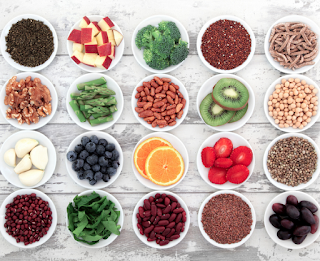"How To Eat Health" includes Three Parts:
- Choosing a Healthy Diet
- Making Easy but Healthy Decisions
- Changing Your Mindset
Part 1 of 3: Choosing a Healthy Diet
1. Choose the right carbohydrates.
- Simple carbs, like sugar and flour, are quickly absorbed by the body's digestive system. This causes a kind of carb overload, and your body releases huge amounts of insulin, to combat the overload. Eat these in moderation. Complex carbs, on the other hand, are slowly digested by the body. They include whole-grain flour, hearty vegetables, oats, and unprocessed grains, like brown rice. These foods are usually higher in vitamins and other nutrients that are beneficial for the body, and they are higher in fiber (which keeps your digestive system running smoothly).
- Consider eating leafy greens like kale, collard greens, mustard greens, and Swiss chard. They are packed with nutrients and will fill you up very quickly. Create a simple sauté with olive oil, garlic, a little salt and pepper, which will be surprisingly tasty meal as well as a nutritious one.
- Choose wheat (brown) bread instead of white bread and whole wheat pasta instead of "normal" pasta. Processed carbohydrates, such as those found in white bread are harder to draw nutrients from, and therefore constitute empty calories. Plain oatmeal is also very healthy for you.
2. Eat lean, mean protein.
Aim to get between 10% and 35% of your daily calories from protein. Protein helps you to build muscle and gives you the lasting energy throughout the day. Some examples of healthy proteins include:
- Lean fish such as flounder, sole, cod, bass, perch, and halibut.
- Lean poultry such as chicken or duck breast.
- Legumes like beans and soy products (e.g. edamame and tofu).
- Nuts like cashews.
You need to consume fat for your body, to function correctly. However, it's important to choose the right kind of fats. Here's a quick primer.
Monounsaturated fats and omega-3 fatty acids are good fats, which you should try to consume regularly. They help lower the "bad cholesterol" in your body by raising "good cholesterol". Foods that are high in fatty acids are olive oil, nuts, fish oil, and various seed oils. Adding these "good" fats to your weekly diet can lower your cholesterol and reduce your risk of heart disease.
Avoid trans fats and saturated fats. Trans fats are form of unsaturated fat commonly found in processed foods, and consuming them raises your risk of heart disease. Read the labels of what you eat, and look for "hydrogenated" anything on the ingredient list.
4. Stock up on superfoods.
So-called superfoods may have a misleading title, but some truly are cut above. Superfoods may have the ability to fight heart disease, stave off cancer, lower cholesterol, and even boost your mood. Here are just few of them:
- Blueberries. Blueberries may facilitate brain health. If you don't have access to blueberries, then try fresh berries, raspberries, or cranberries.
- Algae. It may not sound appetizing, but then again when you read the list of health benefits you may think again. It is rich in vitamins, minerals, and amino acids, as well as beneficial in managing natural flora in the gut.
- Salmon. Another creature of the sea makes the list, and for good reason. Salmon is rich in omega-3 fatty acids, a good type of fat. Omega-3 fats are good for blood pressure, brain function, and heart health.
- Cranberries. These red berries contain Quercetin, a natural anti-Carcinogen (anti-cancer), are low in sugar and a decent source of Vitamin C. Vitamin C is essential for bone health and prevents Scurvy.
Although humans need salt in moderation, too much salt can lead to high blood pressure, osteoporosis, and excessive stomach acid. Use salt sparingly, and always check labels on food for the "reduced sodium" option, if it's available.
Read also: Top 8 Tips For Healthy Eating
6. Practice moderation.
Don't over-consume any one food or type of food. Instead, try to vary your diet so that you eat a little bit of everything in a moderate amount.
Some people might be great at giving up meat, sugar, alcohol, or other foods. However, most of us are likely to give it up for awhile, then break down and binge. Avoid this deprivation-binge cycle by allowing yourself to have small "cheats". For instance, if you want to eat less sugar, allow yourself to eat one dessert each Friday night and abstain for the rest of the week. Having a break to look forward, which can help you power through the other days.
You might also like:
- Part 2 of 3: How To Eat Healthy: Making Easy but Healthy Decisions
- Part 3 of 3: How To Eat Healthy: Changing Your Mindset
Source: wikihow.com

















0 nhận xét:
Post a Comment